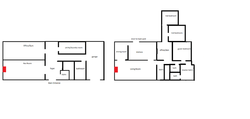First off, since this is my first post, let me say that this forum has been a great help to me so far. I recently moved into a house with 2 fireplaces, and a lot of chimney issues that we're looking to repair, and this place has been a wealth of knowledge.
We've got some water damage in our flue and bricks at the top of the chimney, so we're going to have some repairs done soon. 1 of the fireplaces is really dated, and it got me to thinking about putting in a wood stove to gain a new heat source.
Just from a couple of weeks of reading this forum, I know that this question is beaten to death (and I frequent a lot of forums. I know the questions that get asked a ton are annoying)... BUT... I come bearing details to back up my question.
Question: What floor should I put a wood stove on for heat?
Details: In the attached picture (I hear you all like pictures), I did a quick and dirty sketch of my house layout (not to scale. I am not an artist. etc).
Thoughts?
We've got some water damage in our flue and bricks at the top of the chimney, so we're going to have some repairs done soon. 1 of the fireplaces is really dated, and it got me to thinking about putting in a wood stove to gain a new heat source.
Just from a couple of weeks of reading this forum, I know that this question is beaten to death (and I frequent a lot of forums. I know the questions that get asked a ton are annoying)... BUT... I come bearing details to back up my question.
Question: What floor should I put a wood stove on for heat?
Details: In the attached picture (I hear you all like pictures), I did a quick and dirty sketch of my house layout (not to scale. I am not an artist. etc).
- This is a 2 level house, built into a hill, and the main entrance is what traditionally might be the basement. It has a rec room with 1 fireplace, 1 bedroom, and the utility room. The top level is where all the main living is. Basement rec room would be used daily by kids, basement office would be used daily by me and/or wife for work.
- Home is ~2800 sqft
- Basement rec room has large french doors, which open to the foyer where the stairs run up to the main level
- "Basement" is insulated, as it is not fully below grade
- Wood would be stored in the back yard, which is better accessed from the top level via the kitchen door
- Gas furnace (not sure if relevant)
- Basement rec room fireplace is dated, while upstairs one is more modern.
- 2 chimney guys who gave us quotes both suggested a wood stove install in the basement rec room, for whatever reason.
- I think that I'd probably miss the ambiance of the fire if it was in the basement
- We're thinking of an insert like the Regency CI2600, though I am worried about maintaining a catalytic system as a newbie.
Thoughts?
Attachments
Last edited:



